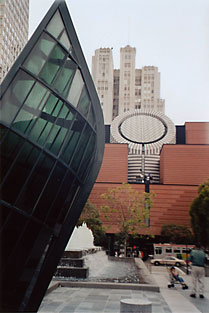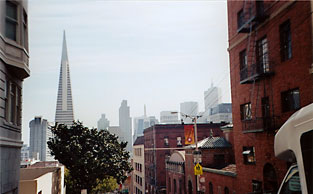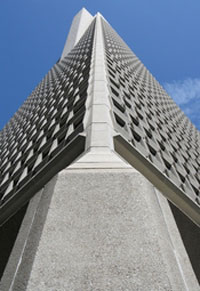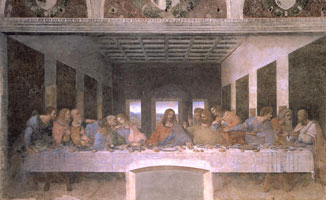|

Seen from a distance,
perched on picturesque hills and refreshingly eclectic in style, the
buildings of San Francisco are stunning. In many ways this is a familiar
sight. A favourite set for cinematographers, the countless movies shot
here have made many of its landmarks easily recognizable.
Strolling along wide pavements, watching the
traffic go by from the safe distance of a less alienating world, where
people still look at each other with a certain degree of confidence, I
felt welcome. Welcome and strangely at home (although I had flown half the
planet to get there). The city’s kind and respectful acknowledgement of
human life possible (even encouraged) out of one’s car is something I have
always been grateful for. Without any doubt, San Francisco is a very
special place. The banality of the statement makes me frown in discomfort
as I write. But bear with me. There is more beyond the obvious.
An uncanny feeling of deja vu is bound
to take hold of most of us, visitors, stepping up and down its steep,
crooked streets, in search of a place or another, or simply strolling
aimlessly. Yes, cinema is largely responsible for our non-lostness in this
brave new world. The joy of discovery is coupled here with the soothing
embrace of the already known. Because of this one feels less of a
stranger. Or no stranger at all…
Embarrassingly predictable and undeniably
self-deluding as it is, the feeling is real and also enriching. Which
raises the question: how something so obviously wrong can lead us to
something clearly meaningful?
By suspension of disbelief we willingly give
up what reason would otherwise tell us to do: dismiss the feeling as false
and unsubstantiated. Dangerous even, to the point of potentially making
fools of ourselves. No matter. Foolish as it may seem, following what in
the beginning is nothing more than a hunch, may open our eyes in ways
unexpected. We are always given a choice.
In this case for instance, I could have
engaged with the wealth of information and advice usually bestowed on
tourists and new-comers to San Francisco. Or forget it and accept I was at
home. I chose to listen to my heart and embrace the space with
unreasonable confidence. Willingly, I distanced myself from the
well-trodden paths and the safety of other people’s advice, opting to
throw myself into the unknown with nothing but a map and the belief that I
was going to be ok and that the hunch was meaningful.
There was the small matter of the conference.
Obviously, this had an impact, limiting some of the possibilities. And the
time involved: just a few days. However, with the detachment of hindsight,
I can now quite safely say that more liberty and a few extra days would
have made little difference. The experience was set within strict
boundaries. This in itself was significant. One immediate effect of
brevity is that, when things really matter, strict boundaries confer an
increased degree of focus and clarity of vision.

Built as it is on
hills (42 to be precise), the city can be viewed from a multitude of
angles. This, of course, makes it very photogenic. But also, more
importantly, it allows perception of the same place from more than one
point of view. From far away, the elegant shapes of the
skyscrapers have an undeniably uplifting effect. Looking at them is quite
an experience. Reflected in their walls of steel and glass is a reassuring
vision of ourselves. That side of us daring beyond common sense,
adventurous, with a taste for pushing frontiers ever more dangerously
further, and able above expectations. In other words, we see what we can
make happen when we decide to overcome what we think are our limits. From
up close however, our perception changes dramatically. On the whole, these
buildings were developed in tight clusters, so, at ground level, the sun
can rarely shine. As for the sky, there is not much of it visible. Sight
is limited and the vision of the whole is not possible.
Instead we are confronted with something else.
Less exhilarating maybe, but equally valuable: the experience of our
smallness and frailty in relation not only to the world we inhabit, but
also our own creations. The discrepancy between the scale of the products
of our imagination and our own diminutive nature is perhaps nowhere as
obvious as it is in architecture.

From a
touchable distance, the vision is not comfortable. But the truth it
reveals is vital. Beyond the exercise in humility it takes us through,
this truth points to something else as well. A fact perhaps slightly more
surprising, but not altogether unexpected in contexts other than the one
under discussion. Mainly that things are rarely what they seem to be and
that great beauty can materialize from oftentimes unbelievable
contradictions.
Take for instance the Transamerica Pyramid,
one of the city’s unmistakable landmarks. From afar the building is
harmony personified. From down beneath it is heavy and puzzling. All in
all, an almost terrifying heap of concrete and glass pushing itself
upwards with a force impossible to stop or re-direct towards another path,
perhaps less seemingly reckless. But having said this, overwhelming as it may
seem when scrutinized from only a few paces away, the structure could not
have been more harmonious, verging on perfection. In 1989, when the
7.1-magnitude Lorma Prieta earthquake stuck the Bay Area, although the
building shook for more than a minute, during which its top swayed almost
a foot from side to side, the Pyramid escaped entirely undamaged. This
does not mean to say that its fate (together with that of other tall
buildings in the Financial District) is secure. San Franscisco is a highly
volatile place of intense and unpredictable seismic activity. How long
they will last is impossible to guess. One thing is sure though. The
design of these buildings is particularly complex and takes into account
the inevitability of huge earthquakes to come.
Beyond the smooth beauty of its perfect shape
there is a lot of thinking visible in the tentative effort to prevent the
worst. The slick, contemporary look of the Pyramid’s surface outstanding
in its simplicity is deceiving. The building’s exterior is covered with
white precast quartz aggregate interlaced with reinforcing rods at four
places on each floor. Panels are not joined to each other to allow lateral
movement and a unique truss system is in place, supporting both vertical
and horizontal loading. Nothing is simple. No line uninterrupted. No stone
unturned in terms of trying to achieve both visual and functional
excellence.
Buildings like the Transamerica Pyramid are
very obvious examples of this particular desideratum at work. But
it is not unique, or indeed confined to architecture. Examples further a
field are no less evident. Let us for instance take the case of a painting
very much in vogue at the moment, Leonardo’s Last Supper. When
approached with an attentive eye, this work reveals extremes of artifice.
They are described in detail in Martin Kemp’s study Leonardo da Vinci –
The Marvellous Works of Nature and Man (Oxford University Press:
2006). Somewhat unexpected in a painting such as the one mentioned above,
making a note of these extremes is essential for our understanding of what
lies beneath the mesmerizing harmony of the fresco.

Painted
onto the walls of the Covent of Santa Maria delle Grazie near Milan, the
state of the Last Supper is painfully bad. Although some of
Leonardo's original touches have been re-brought to the surface in the
restoration recently completed, with this particular work the painter's
daring attempts to revolutionize the technique of fresco were not
successful. In fact, the picture started to deteriorate while Leonardo was
still alive.
Most of the vibrant detail of the fresco is
lost forever. We now only see a pale shadow of what might have been
luscious colours and we have to make an effort of imagination to recompose
the full expression of the characters.
Not all is gone however. From the threshold of
the twilight zone which fate and human error have bestowed upon it, the
fresco glows as meaningfully as ever. We are caught in its web of wonder
and illusion. We are beckoned to raise to the challenge, to open our eyes,
take up the gauntlet and enter the dangerous waters of a game which we all
know may far exceed our capabilities. The invitation to be more than a
passive spectator is there. It is up to us whether we take it or not.
Looking carefully we see that one of the most
conspicuous visual paradoxes is that Leonardo has a chosen a table too
narrow to provide seating for all the characters in the painting. There
are no seats from which Peter and Thomas could have risen. Then there is
the matter of perspective . While seemingly a tidy demonstration of
Albertian principles, Leonardo’s treatment of them is in reality more than
defiant, offering what is in essence an illusionistic alternative.
The first hint of his departure from the norm
is in the viewpoint. The rules (which, by the way, Leonardo fully
subscribed to) say that the painter must portray things realistically in
their setting and that he must place the eye below the object he sets to
paint. In terms of the Last Supper however, this meant that the
viewer would not have been able to see the upper surface of the table and
quite a lot of the disciples’ bodies. Something which Leonardo was not
prepared to do as thus he would have compromised the clarity of the
narrative exposition.
The actual viewpoint of the painting is in an
impossible position at more than twice the height of a man. The only way
to counter-balance this is to view the fresco from an off-centre position
within the refectory. In this case one of the lateral walls of the
painting aligns reasonably well as an extension of the wall of the room.
However, the other wall in the painting will be thrown badly out of
alignment with the corresponding feature in the actual space as a result.
In non-technical terms what this means is that
Leonardo effectively removes the concept of an ideal viewpoint, ensuring
that no spectator could claim to occupy a privileged position in relation
to the painting. In other words, from our imperfect place in the real
world we are all made equal to each other. And we are all fooled. What
seems a perfect extension of our universe into a quintessentially
naturalistic type of painting is an illusion.
However, the way we have embraced this
illusion from the day it was unveiled suggests something rather important.
That Leonardo’s Last Supper looks logical because we look at it
assuming it is. Even complete awareness of the contrivance does not
destroy the impression of reality. But things, the painter seems to say,
are rarely what they appear to be. Even when truth stares us in the face.
The world encapsulated in the work of art
cannot (indeed should not) be made to fit the tight glove of mundane
reality. If it is going to be an extension at all it should be up-lifting.
Literally. Very much like the viewpoint in the Last Supper, which
is not only off-centre, but high above the ground.
We should accept, that, in a metaphorical way,
this is how we should position ourselves in relation to the gifts we
ceaselessly receive, be they extraordinary cities, great works of art or
meaningful truths in our lives. If we look from up close, we are bound to
notice that almost invariably, they are not smooth, perfectly logical or
harmonious. They defy rather than submit to what we want them to be.
Indeed to what we can imagine them to be.
The lesson of San Francisco… while walking
among colourful houses and pyramids of glass. Listening to my heart.
Trusting the Power that entrusts itself to it, helping us see the world as
it is and each other. In the fragile depths of its whisper - it dawned to
me - is the light and the knowledge of the next step to follow.
Oxford, 28 May 2006
|